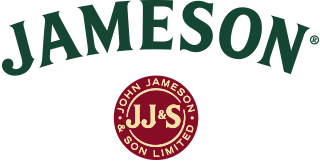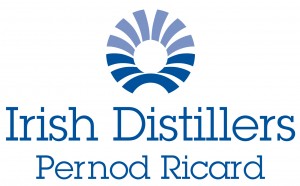Related Research Articles

Irish whiskey is whiskey made on the island of Ireland. The word 'whiskey' comes from the Irish uisce beatha, meaning water of life. Irish whiskey was once the most popular spirit in the world, though a long period of decline from the late 19th century onwards greatly damaged the industry, so much so that although Ireland boasted at least 28 distilleries in the 1890s, by 1966 this number had fallen to just two, and by 1972 the remaining distilleries, Bushmills Distillery and Old Midleton Distillery, were owned by just one company, Irish Distillers.

A pot still is a type of distillation apparatus or still used to distil liquors such as whisky or brandy. In modern (post-1850s) practice, they are not used to produce rectified spirit, because they do not separate congeners from ethanol as effectively as other distillation methods. Pot stills operate on a batch distillation basis. Traditionally constructed from copper, pot stills are made in a range of shapes and sizes depending on the quantity and style of spirit desired.

Jameson is a blended Irish whiskey produced by the Irish Distillers subsidiary of Pernod Ricard. Originally one of the six main Dublin Whiskeys at the Jameson Distillery Bow St., Jameson is now distilled at the New Midleton Distillery in County Cork. It is by far the best-selling Irish whiskey in the world; in 2019, annual sales passed 8 million cases. It has been sold internationally since the early 19th century, and is available to buy in over 130 countries.

Paddy is a brand of blended Irish whiskey produced by Irish Distillers, at the Midleton distillery in County Cork, on behalf of Sazerac, a privately held American company. Irish Distillers owned the brand until its sale to Sazerac in 2016. As of 2016, Paddy is the fourth largest selling Irish whiskey in the World.
Aeneas Coffey (1780–1839) was an Irish inventor and distiller.

Powers is a brand of Irish whiskey. Historically a single pot still whiskey, the flagship Powers Gold Label brand was the first Irish whiskey ever to be bottled. In recent years, several single pot still variants have been relaunched under the Powers label.

Midleton Very Rare is a premium Irish whiskey, produced by Irish Distillers at the New Midleton Distillery, in the East Cork town of Midleton, from which it gets its name. A non-age statement whiskey, containing a mix of pot still and grain whiskeys, it is matured for about twelve to twenty years in ex-bourbon American Oak barrels. One of the most expensive whiskeys regularly produced by Irish Distillers, since its launch in 1984, Midleton Very Rare has frequently been the recipient of strong reviews and awards.

Irish Distillers is a subsidiary of the French drinks conglomerate Pernod Ricard. It is the largest distiller of Irish whiskey, distilling popular brands such as Jameson and Powers, in addition to premium whiskeys such as Redbreast and Midleton Very Rare. In addition to whiskey, Irish Distillers also produces a number of other spirit products such as gin and vodka.
Cork Distilleries Company was an Irish whiskey distilling company. It was formed in 1867, when four Cork distilleries, Daly's, the Green, North Mall, the Watercourse were amalgamated under one company to form the Cork Distilleries Company. In 1868, these were joined by another Cork distillery, James Murphy's Midleton Distillery. The company existed until 1966, when the Cork Distilleries Company merged with two other Irish distillers, John Powers & Son and John Jameson & Son, to form Irish Distillers.
Jameson Distillery Bow St. is an Irish whiskey tourist attraction located just off Smithfield Square in Dublin, Ireland. Jameson Distillery Bow St. is the original site where Jameson Irish Whiskey was distilled until 1971. It is now a visitors centre that provides guided tours, tutored whiskey tastings, JJs bar and a gift shop.
The Jameson Experience, Midleton, is an Irish whiskey museum and visitor centre located in the Old Midleton Distillery in Midleton, County Cork, Ireland. Set over 15 acres, since opening as a visitor's centre in 1992, the old distillery has received approximately 100,000 guests per year, receiving 125,000 in 2015.
Allman's Bandon Distillery was an Irish whiskey distillery which was established in 1826 in Bandon, County Cork, Ireland. The distillery closed in 1929 following financial difficulties. However, agents for the company trading under the name Allman, Dowden & Co., may have continued to sell off the existing stock which had built up in bonded warehouses, in both cask and bottled form, until 1939.
The North Mall Distillery was an Irish whiskey distillery located in Cork City, Ireland. In its day one of the most famous distilleries in Ireland, the distillery was destroyed by a fire in 1920. Distilling operations never resumed at the North Mall after the fire, and it was later converted into a bottling and storage facility which was used by Irish Distillers until 2007, at which point operations were transferred to Irish Distillers' other bottling facilities in Dublin. In the mid-2000s, much of the site was jointly acquired by University College Cork and Mercy University Hospital, and has since been redeveloped.

The Dundalk Distillery was an Irish whiskey distillery that operated in Dundalk, County Louth, Ireland between 1708 and 1926. It is thought to have been one of the old registered distilleries in Ireland. Two of the distillery buildings, the grain store and maltings, still exist and now house the County Museum and Dundalk Library.

Daly's Distillery was an Irish whiskey distillery which operated in Cork City, Ireland from around 1820 to 1869. In 1867, the distillery was purchased by the Cork Distilleries Company (CDC), in an amalgamation of five cork distilleries. Two years later, in 1869, as the smallest CDC distillery, Daly's Distillery ceased operations. In the years that followed its closure, some of the buildings became part of Shaw's Flour Mill, and Murphy's Brewery, with others continuing to be used as warehouses by Cork Distilleries Company for several years.
The Green Distillery was an Irish whiskey distillery which was established in Cork City, Ireland in 1796. In 1867, the distillery was purchased by the Cork Distilleries Company (CDC), in an amalgamation of five Cork distilleries. Production of whiskey at the distillery likely ceased soon afters its acquisition by the CDC. However, the distillery is known to have remained in use a bonded store by the Cork Distilleries Company for several years thereafter. In the mid-twentieth century, the distillery resumed operations as a gin distillery for a period of time, however, it has since been almost completely demolished.
The Watercourse Distillery was an Irish whiskey distillery which was established in Cork City, Ireland in 1795. In 1867, the distillery was purchased by the Cork Distilleries Company (CDC), in an amalgamation of five Cork distilleries. Following the amalgamation, the distillery was mothballed for a period at the beginning of the 20th century. However, operations at the distillery were later resumed, with production of yeast, industrial alcohol and grain alcohol occurring at the distillery until the 1970s. Distillation ceased at the facility in 1975, when Irish Distillers, who at that stage owned the Watercourse along with several other distilleries in the Republic of Ireland consolidated its operations in a new, purpose-built distillery in Midleton.
The Old Tullamore Distillery was an Irish whiskey distillery which was established in Tullamore, County Offaly, Ireland, in 1829. The original home of Tullamore Dew Irish whiskey, the distillery closed in 1954, having endured financial difficulties for many years, like many Irish whiskey distilleries of the early 20th century.

Bishop's Water Distillery was an Irish whiskey distillery which operated in Wexford, Ireland between 1827 and 1914. The distillery was named for a stream which ran along the back of the distillery, the Bishop's Water, said to possess "various occult properties derived from the blessings of the sainted Bishop of Ferns".
Marlfield Distillery was an Irish whiskey distillery which operated in the village of Marlfield, just outside of Clonmel, Ireland between approximately 1817 and 1856.
References
- 1 2 3 4 5 6 7 8 Townsend, Brian (1997–1999). The Lost Distilleries of Ireland. Glasgow: Neil Wilson Publishing. ISBN 9781897784877.
- ↑ "Excise Sale". Southern Reporter and Cork Commercial Courier. 4 April 1843.
- 1 2 3 4 5 "In the Landed (Lately Incumbered Estates Court, Ireland". The Advocate: or Irish Industrial Journal. 10 July 1850.
- 1 2 3 4 5 6 7 8 "NISI PRIUS COURT-Monday". Cork Examiner. 12 December 1845.
- 1 2 "Sale of Incumbered Property in Cork". Dublin Mercantile Advertiser. 4 October 1850.
- ↑ "Sale of Incumbered Property in Cork". The Evening Freeman. 30 September 1859.
- 1 2 3 Byrne-Rothwell, Daniel (2010). The Byrnes and the O’Byrnes, Volume 2: A Social History of the Clan. Great Britain: House of Lochar. p. 297. ISBN 9781904817048.